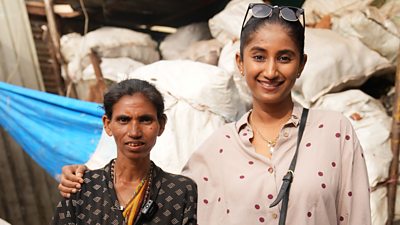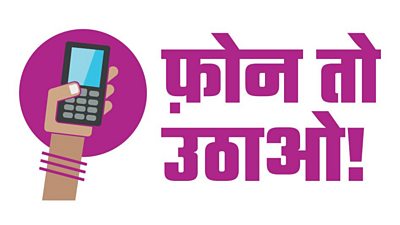By my memory, leprosy in India was the first-ever �鶹Լ�� Media Action project, when �鶹Լ�� Media Action was still known as �鶹Լ�� World Service Trust - that was 25 years ago.
As I recall it, it was in the final months of 1999. I was three years into my stint as �鶹Լ�� South Asia correspondent, based in Delhi, and I went with local producer Shubhranshu Choudhary to the building in east Delhi for the launch of a leprosy awareness project in northern India – focusing our attention very much on the state of Bihar.
The idea was to help spread information to help people with leprosy access treatment. Those who had leprosy could, it was hoped, be cured if they could get access to a multi-drug therapy that had been developed. Or - if they had advanced to the stage where they had become disfigured - then their lives could be much improved if they could get surgery.
The government planned to make the drugs more widely available, as well as the surgery. One of the big problems was the stigma attached to leprosy. It was difficult to convince individuals, families of those affected and communities that those with leprosy could be treated and could have much better lives.
That’s where the-then World Service Trust came in - encouraging and helping local print, radio (and, where they existed, TV) journalists to convey this information, producing social advertising, street theatre performances about leprosy, and more.
I’m pretty sure I was told by the Trust that it was the first project in the world of its nature to get off the ground. I was based in Delhi for another two years and remember being told that, following this project and wider health-system efforts, health officials found over 450,000 of leprosy in India.
This was attributed, at least in part, to the success of the World Service Trust/Media Action project – because more people were identified and coming forward for treatment. In terms of tackling the stigma that held patients back from accessing drugs and/or surgery it was, of course, very much an early example of countering misinformation.
The World Service Trust office in Delhi went on to carry out a major HIV awareness project – the impact of AIDS in India being a topic I had also reported on for the �鶹Լ��. Andrew Whitehead, who was the India director of the World Service Trust from 2005 to 2007, says: “Our big work was a (UK Department for International Development)-supported project making high quality TV series with HIV messaging for Doordarshan, India’s state broadcaster. We made a marvellous detective series – the detective was HIV positive – and a reality programme which worked with Bollywood stars.”
“We also had a small but wonderful project developing a women’s radio programme using citizen journalists. And towards the end of our time we got the World Service Trust’s first Gates-supported project (tackling) HIV.”
Today, 25 years later, �鶹Լ�� Media Action’s work in India spans health, gender rights, more inclusive societies and climate change. The projects and programmes have grown and changed for a rapidly changing digital world - and they have never been more important.
Mike Wooldridge was a �鶹Լ�� Media Action trustee until his term ended in June 2024. He remains a staunch supporter of �鶹Լ�� Media Action.
Read one of his original reports .
Latest news
-

INSIGHT: Influencing for good: It works!
Learn how social media influencers can kickstart social change by sparking conversations to shift mindsets. -

'There is definitely a shift in the way people see me'
Indira explains how attitudes are beginning to shift toward the waste pickers of Bengaluru on the �鶹Լ��'s People Fixing the World podcast. -

Saving lives with mobile health communication: Kilkari in the BMJ
The trusted voice of 'Dr Anita’ shares health information with 10 million families in our Kilkari project in India - with demonstrated impact, as shared in the BMJ Global Health. -

INSIGHT: Designing for inclusion - from invisible to #Invaluables
Bengaluru, India’s Silicon Valley, generates 5,757 metric tonnes of solid waste per day, much of it recycled by informal waste pickers. Our PRIDE project is challenging negative attitudes about their valuable role - read how research and insight is informing our creative approach. -

INSIGHT: How poo became our biggest creative challenge
With 60% of urban India not connected to modern sewerage systems, what happens after we flush is a pressing health issue. We look at the thinking behind our revolutionary drama series Navrangi. -

Storytelling for impact: Navrangi returns in a colourful second series for web
�鶹Լ�� Media Action’s one-of-a-kind drama which examines sanitation issues alongside other life and love in the neighbourhood – has launched on YouTube. -

INSIGHT: How can digital technology empower women without worsening inequality?
Our digital director Sara Chamberlain examines the question emerging as use of mobile technologies surges in India: can the digital revolution be harnessed to empower women – socially, economically and politically - without creating deeper social and gender divides? -

Accelerating digital adoption in women’s collectives – a proof of concept
Learn more about how we are creating bite sized video and audio content for a WhatsApp chatbot learning aid, to help address the digital gender gap. -

Can social media output help shift perceptions about informal waste pickers?
This summary looks at findings from research conducted on �鶹Լ�� Media Action’s ‘A Pathway to Respect, Identity, Dignity and Empowerment’ (PRIDE) project - which aims to shift negative perceptions about informal waste pickers and highlight their contribution to society in the city of Bengaluru in India. -

Making the invisible, visible with the Demon of Defeca
Our Global Creative Advisor highlights why behaviour change is as important in the conversation on sanitation in India as infrastructure, and introduces our creative strategy and poo demon, Malasur. -
 �鶹Լ�� Media Action blog
�鶹Լ�� Media Action blog

